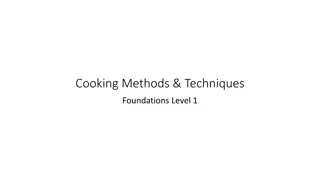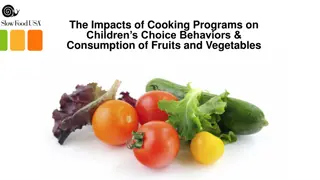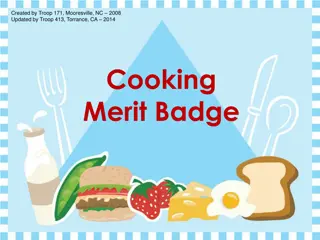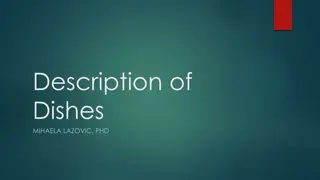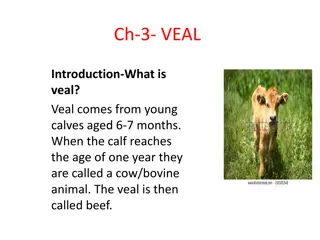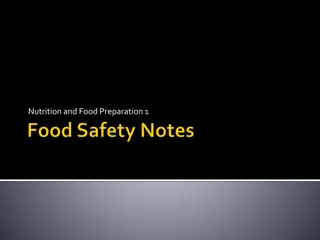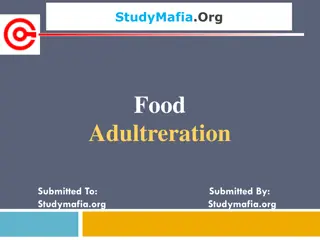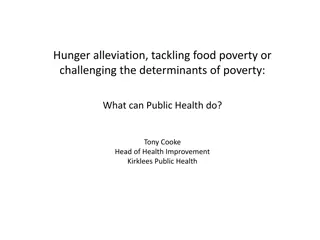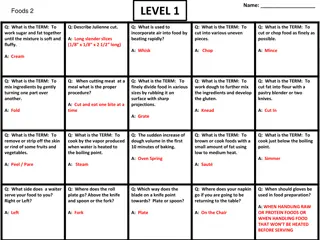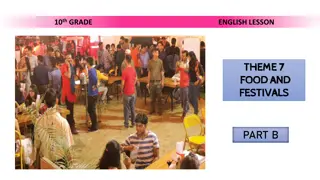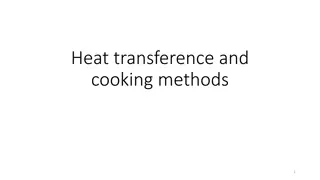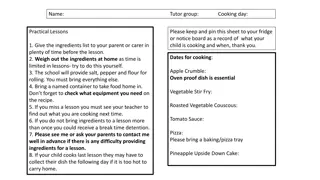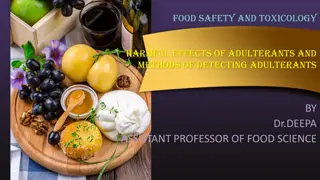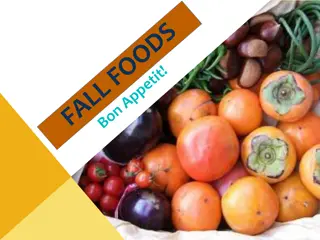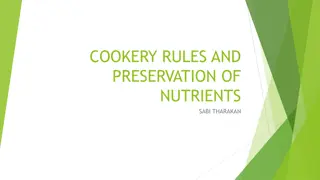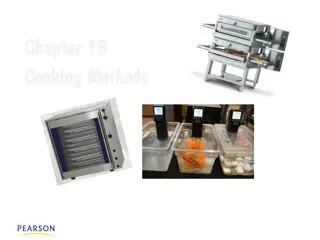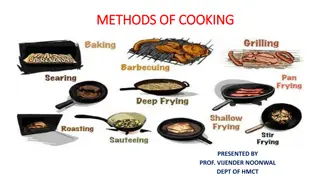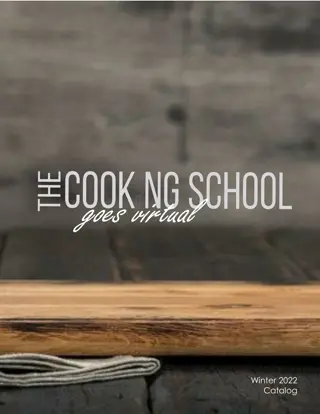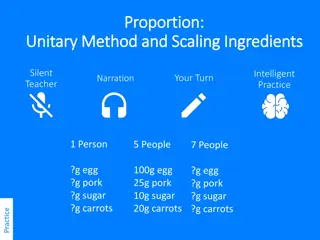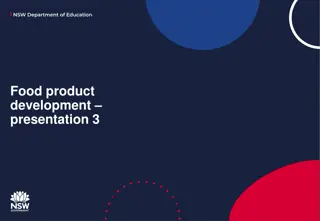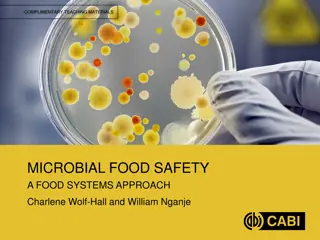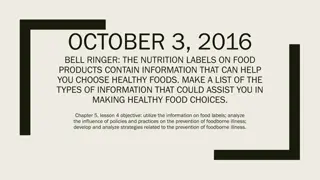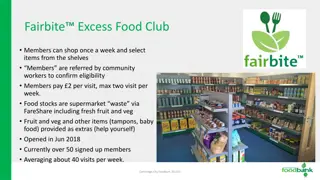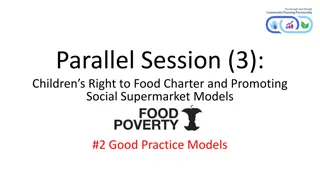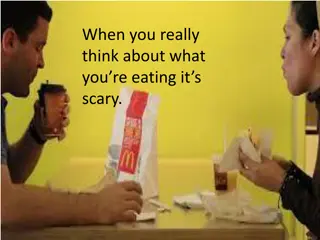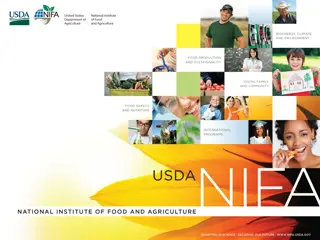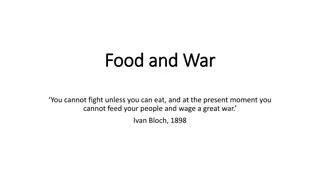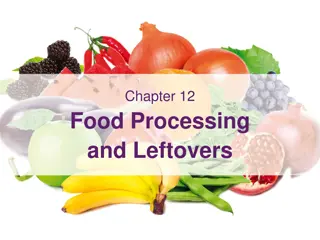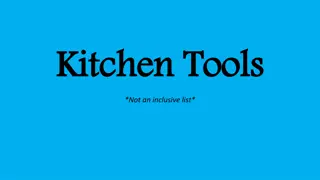Understanding Cooking Methods and Their Impact on Food
Cooking is not just about preparing food; it involves various methods that affect taste, texture, and nutrients. Different heat transfer methods play a crucial role in how food cooks, and understanding dry heat, moist heat, and combination cooking methods can help achieve desired results. From sautéing to deep frying, each technique influences the final outcome of the dish in unique ways.
Download Presentation

Please find below an Image/Link to download the presentation.
The content on the website is provided AS IS for your information and personal use only. It may not be sold, licensed, or shared on other websites without obtaining consent from the author. Download presentation by click this link. If you encounter any issues during the download, it is possible that the publisher has removed the file from their server.
E N D
Presentation Transcript
Cooking Methods, terminology and how food cooks
You cook food because Cooking kills bacteria: Some foods cannot be served raw, like poultry. Cooking makes food easier to digest. Cooking changes the taste, aroma and appearance of food.
Food is made up of Water, which evaporates when cooked. Fats, which melt when cooked. Proteins, which coagulate, or become firmer when cooked. Nutrients, such as vitamins and minerals which are destroyed by cooking. Carbohydrates sugars, which caramelize or become brown when cooked. starches, which gelatinize or absorb water and swell when cooked.
Heat transfer Heat travels to food from its source in a number of ways: Convection means currents of air, steam, water or fat carry the heat to food. Like when currents of hot air heat the food in an oven. Conduction means something hot touches the food. Like when a steak is cooked in a hot frying pan. Radiation means heat radiates from a heat source to the food. Like when heat radiates from the coals on a barbeque to the food.
Cooking methods Cooking methods are the techniques we use in the kitchen to get the results we want. For example, you could boil or poach a steak but that would not get the result you want, which is probably a brown tasty crust with a pink interior. Cooking methods are classified as either: Dry heat methods, which means no moisture is added Moist heat methods, which involve either water or steam Combination methods, which involve dry heat and then a moist heat.
Dry heat methods Dry heat methods mean cooking without any water or steam, although some kind of cooking oil is often used. Dry heat methods are for foods which are naturally tender.
Saute which means to toss quickly in a pan with very little fat and a fairly high heat. Fairly high heat, very little fat
Pan fry which means to cook in a moderate amount of fat over a moderate heat. Usually breaded foods like cutlets or chicken are pan fried. Moderate heat & a moderate amount of fat
Deep fry which means to submerge something completely in cooking oil, like french fries 350 degrees Fahrenheit Completely submerged in hot fat
Pan broil which means to cook something in a pan with no added fat. A moderate heat, no fat Usually foods which have their own fat, like steaks, burgers or bacon
Roast or bake which means to cook by exposing food to hot, dry air in an oven To cook by exposing to hot, dry air
Griddle which means to cook food on a flat, hot surface. This is very common because a griddle can cook many foods quickly. To cook on a flat, hot surface
Grill which means to cook food on metal bars over radiant heat. To cook on bars, over radiant heat Barbequing is almost identical, except that the heat traditionally comes from wood or charcoal.
Moist heat methods Moist heat methods mean cooking food in water or steam.
Poaching which means to cook food in water that is hot but not bubbling. Usually tender, delicate foods, like eggs. Hot, but not bubbling.
Simmering which means to cook food in water that is bubbling gently. Usually foods that need to cook for a long time. Bubbling very gently.
Boiling which means to cook food in water that is bubbling rapidly. Usually foods like pastas or hardy vegetables. Bubbling very rapidly.
Steaming which means to cook food by exposing it to steam. Usually potatoes and vegetables.
Combination methods Combination methods mean cooking food using first a dry heat and then adding liquid or steam. Combination methods are used to tenderize tough cuts of meat.
Braising which means to brown the food first and then cook it covered, with moisture added. Braised dishes are always cooked covered because this keeps the moisture in. Braising tenderizes tough cuts of meat or poultry.
Stewing which means to cut food into bite size pieces, brown it and then cook it covered, with moisture added. Stewed dishes are always cooked covered because this keeps the moisture in. Stewing tenderizes tough cuts of meat or poultry.
Cooking terms Reduce means to simmer a liquid so some of it evaporates. This concentrates the flavors. Parcook means to partly cook food. Parboil means to partly cook by boiling. Parbake means to partly cook by baking. Blanch is to partly cook by boiling or steaming. Glaze means to add a shine to the food. Deglaze means to swirl a liquid in a pan to dissolve cooked particles of food. Sweat means to cook in fat over low heat. Sear means to brown the surface of a food quickly, usually by sauteeing or pan broiling. Season means to enhance the natural flavors. Flavor means to add a new taste to food.
THANKS MACKY AMORES


